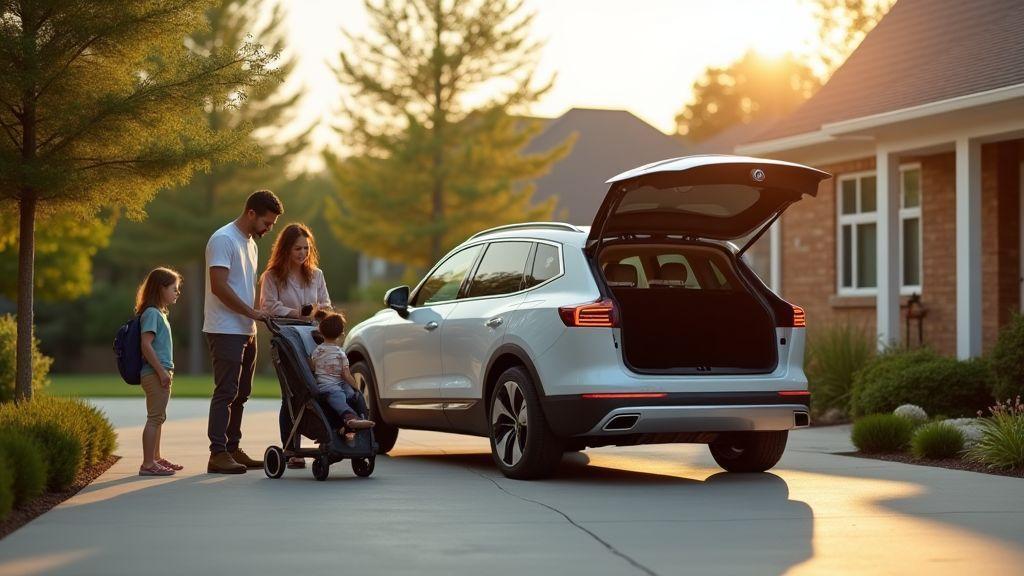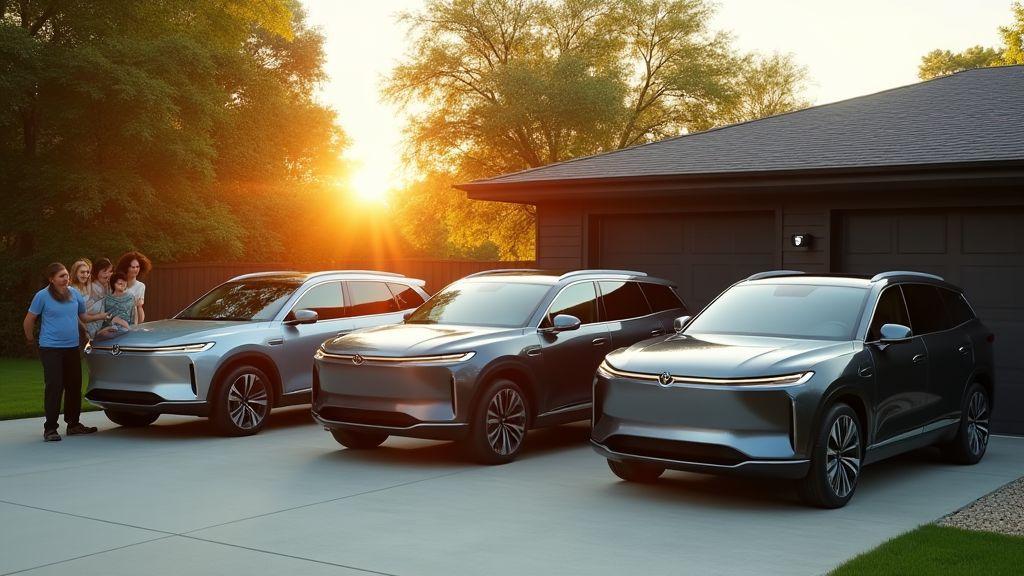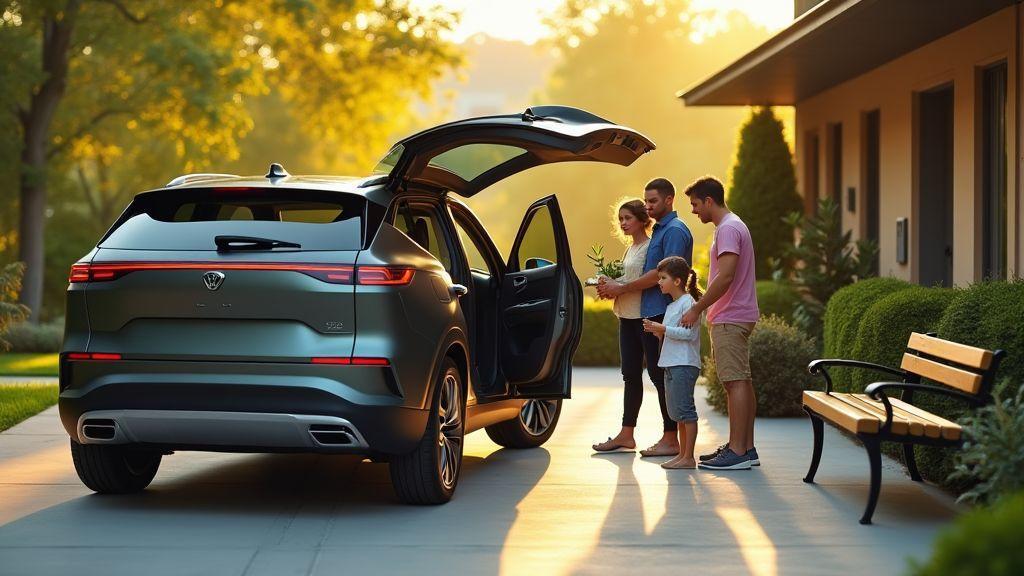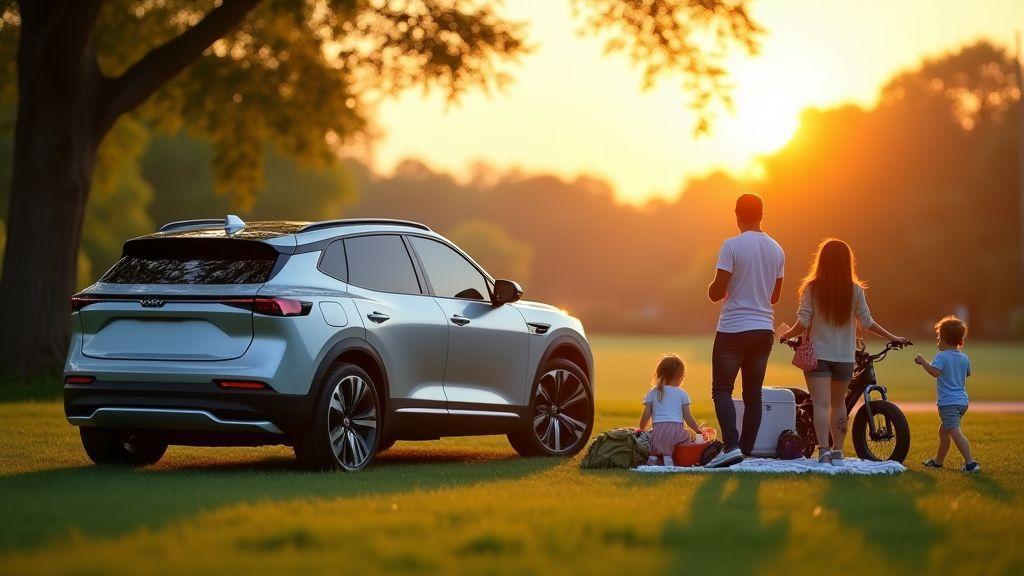Best Hybrid SUVs for Families in 2025
You need a safe, roomy, and fuel‑smart family SUV. This guide shows how crash ratings protect your family and which safety tech to demand. Learn how to check safety ratings before you buy, see which three‑row hybrids fit car seats and offer easy access, and test seats on a short drive to judge comfort. Compare fuel efficiency, real‑world range, plug‑in versus full hybrid tradeoffs, and road‑trip planning tips. Measure cargo space for strollers and bikes, learn smart packing hacks, and work out true cost by weighing price, fuel savings, maintenance, and incentives. Read expert and owner reviews, compare trims and warranties, and use the final checklist to pick the Best Hybrid SUVs for Families in 2025.
Key Takeaway
- Choose a hybrid with strong safety features to protect your family.
- Pick roomy seating and large cargo space so your family rides comfortably.
- Look for good fuel economy to save money on long trips.
- Prefer simple, reliable tech and driver aids that keep you focused.
- Weigh upfront price and low running costs to fit your family budget.

Safest hybrid SUVs for families 2025 and crash ratings
You want a hybrid SUV that keeps your kids safe and gives you peace of mind. Crash‑test programs like IIHS, NHTSA, and Euro NCAP run impact tests and score cars on occupant protection. Look for models that score high across frontal, side, and roof‑strength tests — those scores quickly show which hybrids put family safety first. Best Hybrid SUVs for Families in 2025 will usually show strong structure and consistent airbag performance.
Beyond raw scores, watch child‑occupant and small‑overlap results. A Top Safety Pick or five‑star rating is a green flag, but dig into the details — some SUVs ace frontal crashes but do less well in small‑overlap hits that stress the driver side. For practical safety, also check recalls, child seat fit, roof strength for rollovers, and features like easy LATCH anchors and wide rear doors. Also View NHTSA crash test ratings for federal star and rollover details.
Agency | What they test | Top rating example
- — | — | —
IIHS | Small overlap, moderate overlap, side, roof strength, headlights, child protection | Top Safety Pick
NHTSA | Frontal, side, rollover risk; uses star ratings | 5 stars
Euro NCAP | Adult & child protection, pedestrian safety, safety assist | 5 stars
How crash tests protect your family
Crash tests use barriers and instrumented dummies to measure forces and predict injury risk. They show whether passenger space stays intact and whether airbags deploy correctly and on time. Test breakdowns help match a car to your priorities: commuter safety, highway stability, or child‑seat security.
Standard and advanced safety tech to look for
Expect a strong cage, front and side airbags, active head restraints, and solid seat belts. For family life, easy‑to‑use LATCH anchors and wide rear doors are essential. Advanced driver aids close the gaps that crashes can’t predict — look for:
- Automatic emergency braking (AEB) with pedestrian and cyclist detection
- Blind‑spot monitoring with rear cross‑traffic alert
- Lane‑keep assist and lane‑departure warning
- Adaptive cruise control with stop‑and‑go
- Rear‑seat reminders and clear LATCH access
How you check safety ratings before you buy
Start at Check IIHS vehicle crash ratings and NHTSA.gov to read full reports and watch crash videos where available. Compare ratings across agencies and read child‑occupant sections. Test‑fit your car seat at the dealer, check door openings and LATCH locations, and search for recent recalls and owner feedback about how safety systems perform day‑to‑day.
Hybrid SUV seating and comfort 2025 with three‑row options
Three‑row hybrid SUVs in 2025 give you choices that match real family life: adjustable second rows, sliding captain’s chairs, and fold‑flat third rows that free cargo space quickly. Pay attention to headroom, seat cushioning, and lumbar support — long drives reveal what a short showroom test won’t. Hybrids often add sound insulation, so cabins can be calmer even when the engine cycles.
Think about routines: if you carpool kids, a bench second row with three proper belts may beat two captain’s chairs; if you haul gear and people, one‑hand fold‑flat third rows are invaluable. The Best Hybrid SUVs for Families in 2025 balance fuel savings with seating that works for daily life.
Choosing three‑row hybrid SUVs 2025 for growing families
Start with how you use the space each week. Some third rows are kids‑only; others can hold adults for short trips. Factor in doors, step‑in height, and cargo behind the third row. Test with real items — strollers, high chairs, folding bikes — rather than relying on specs.
What to check | Why it matters | Quick target
- — | — | —
Second‑row legroom | Keeps middle‑row passengers comfortable on longer drives | At least 36 inches for adults
Third‑row usable space | Determines if kids or adults fit | Flat floor and decent headroom for kids
Cargo behind row 3 | Shows if you can carry strollers plus people | Enough room for a stroller small bag
Child seat fit, legroom, and ease of access for your kids
Child seat fit is the top practical issue. Try your car seats before you buy; see Guidance on child passenger safety for installation tips. Look for easy‑to‑reach lower anchors and clear belt paths. Sliding second rows and wide‑opening rear doors make installation and daily loading simpler.
- Bring one of your child seats and install it in the second row, then in the third row if planned.
- Check anchor accessibility, belt routing, and how tight the seat becomes after installation.
- Sit behind the child seat to gauge adult legroom.
- Simulate daily loading: diaper bag plus groceries while a child waits in the seat.
How you test seats and comfort on a short drive
Simulate real trips: bring a loaded diaper bag, booster, or car seat and have an adult sit behind each occupied seat to feel legroom and visibility. Drive local streets with frequent stops, then a steady stretch to judge lumbar support and noise. Note how easy it is to reach controls, adjust headrests, and fold or slide rows while passengers remain seated.

Fuel‑efficient family SUVs 2025
Many 2025 family hybrids offer third‑row options, solid cargo space, and trusted safety tech. Some aim for maximum MPG with full‑hybrid drivetrains; others use plug‑in systems for short electric‑only trips. For daily school runs and highway commutes, a full hybrid often hits high steady MPG without needing nightly charging, which simplifies life. You can Compare fuel economy and ownership costs to see official MPG figures and 5‑year estimates before you narrow your list.
If you want the Best Hybrid SUVs for Families in 2025, focus on crash‑test scores, rear‑seat comfort, and cargo layout as much as fuel numbers. Fuel savings should be part of the package, not the whole story.
Long‑range hybrid SUVs for road trips 2025
For long trips, pick an SUV that can cover highway miles without constant pit stops. Long‑range PHEVs give you electric miles for city sections and good hybrid MPG on highways if you can charge at hotels or stops. Full hybrids shine on long drives when chargers are scarce; they switch seamlessly and sustain solid MPG.
Also check towing limits, roof load, and cargo fit before packing. A roof box, bikes, and suitcases add weight and drag that reduce efficiency.
Real‑world MPG and electric range figures to expect
Real‑world MPG and EV range vary by model, load, and driving style. Typical expectations:
Example model type | Typical real‑world combined MPG (after battery) | Typical electric‑only range (miles)
- — | —: | —:
Compact full hybrid SUV | 35–45 mpg | N/A
Mid‑size full hybrid SUV | 30–40 mpg | N/A
Plug‑in hybrid SUV (long‑range) | 30–40 mpg (after EV) | 25–45 miles
Small plug‑in SUV | 28–38 mpg (after EV) | 15–30 miles
If you drive mostly short trips and can charge at home, PHEVs can cover daily miles electrically. If you haul luggage on highways, count on hybrid MPG after the EV range ends.
Plug‑in vs full hybrid: what saves fuel on long trips
If chargers are reliable along your route, plug‑in hybrids save the most fuel: electric for town driving, hybrid for highway. When chargers are rare, full hybrids often win by avoiding charging stops and delivering consistent MPG.
How you plan a road trip to maximize range and efficiency
Charge PHEVs before you leave, choose routes with predictable charger access, maintain tire pressure, cruise at steady speeds, and pack light. Use apps to find chargers and plan breaks around charging or driver rest. The Department of Energy provides charger maps and planning tips to Plan charging for plug‑in road trips.
Hybrid SUVs with best cargo space 2025 and family gear planning
You want room for a stroller, sports gear, and groceries without turning loading into a puzzle. The Best Hybrid SUVs for Families in 2025 usually blend cargo volume with useful layouts: flat load floors, low lift‑over heights, and seats that fold nearly flat. Models like the RAV4 Hybrid, CR‑V Hybrid, and Escape Hybrid often top lists because they combine roomy cargo areas with easy folding seats.
Cargo shape matters as much as liters. Wide openings, square corners, and shallow wheel wells let you slide in a double stroller or a couple of bikes without trouble.
SUV example (hybrid) | Cargo behind 2nd row (approx.) | Cargo with seats down (approx.) | Best use
- — | —: | —: | —
RAV4 Hybrid | 37–38 cu ft | 69–70 cu ft | Easy stroller fit, flat floor
CR‑V Hybrid | 33–39 cu ft | 68–74 cu ft | Deep storage, good width
Escape Hybrid | 33–40 cu ft | 65–68 cu ft | Low lift‑over, good for groceries
Measuring cargo room for strollers, bikes, and groceries
Bring the stroller or measure its folded dimensions. Fold rear seats and check clearance from the cargo lip to the rear glass. Note whether the hatch opens wide enough to angle in bulky items without scuffing paint.
- Measure folded height and width of your stroller or bike with handlebars turned.
- Compare to the cargo opening width, height, and usable depth behind the rear seat.
- Test loading with seats up and down to see real clearance.
Flexible storage features that make daily life easier
Split‑fold rear seats, under‑floor bins, and removable cargo covers add versatility. Look for tie‑down hooks, a 12V outlet in the cargo bay, and rear‑seat release levers reachable from the cargo area — small features that save time on busy mornings.
How you pack and organize family cargo for trips
Pack heavy items low and centered. Use collapsible bins and soft bags so you can stack and flex around wheel wells. Keep a small kit with rain covers, wipes, and a cargo net for quick grabs.

Affordable hybrid SUVs for families 2025 and total cost of ownership
Pick a family SUV that saves at the pump and still fits car seats and gear. The Best Hybrid SUVs for Families in 2025 balance sticker price, running costs, and how long you plan to keep the car. Hybrids cut city fuel use most, which matters for school runs and errands. Watch cargo space and child‑seat ease — practical details that affect daily life more than glossy brochures.
Purchase price starts the calculation, but include fuel, insurance, maintenance, and depreciation. Treat battery warranty terms as part of maintenance planning.
Model (example) | Est. Purchase Price | Est. Annual Fuel Cost | Est. 5‑yr Maintenance | Simple 5‑yr Ownership Cost
- — | —: | —: | —: | —
Toyota RAV4 Hybrid (2025) | $33,000 | $1,300 | $1,200 | $40,700
Honda CR‑V Hybrid (2025) | $32,000 | $1,200 | $1,300 | $39,300
Hyundai Tucson Hybrid (2025) | $30,000 | $1,400 | $1,100 | $38,100
Available incentives, tax credits, and rebates to lower cost
Federal tax credits, state rebates, and local utility incentives can shave thousands off net cost — PHEVs often qualify for larger credits. See Current federal plug‑in tax credit details for eligibility and rules. Some states offer reduced registration or carpool access. Dealers also run lease specials, low APRs, and cash incentives; ask which incentives apply to the exact trim and VIN. When you share personal details to apply for offers or dealer quotes, review the site’s privacy practices and data use.
How you set a budget and compare true ownership costs
Write down annual miles, ownership length, and upfront cash. Subtract expected incentives from purchase price, then add five years of fuel, insurance, maintenance, and depreciation. Compare totals, not monthly payments.
- Estimate annual miles and fuel cost for each model.
- Collect warranty and battery coverage details.
- Add insurance and routine service per year.
- Subtract likely incentives and tax credits.
- Compare total five‑year costs to pick the best value.
Top hybrid SUVs 2025 family reviews and how to choose your best pick
You want a hybrid SUV that saves fuel, fits car seats, and keeps kids happy on road trips. The Best Hybrid SUVs for Families in 2025 mix good fuel economy with roomy cabins and modern safety tech. Read expert fuel tests, crash ratings, and owner reports to see which models deliver beyond marketing claims.
Look at everyday family performance: stroller cargo, second‑row space for boosters, and infotainment usability. Some hybrids trade cargo for battery space; others keep cargo but offer modest MPG gains. Test‑pack your stroller and grocery bags to see what fits.
What expert reviews and owner feedback tell you
Experts measure MPG, how the hybrid system transitions, brake feel, acceleration, and towing. Crash‑test scores and car‑seat install ease matter more than horsepower for family buyers. Owner feedback highlights infotainment glitches, real‑world MPG, and recurring annoyances that single reviews miss.
Comparing trims, warranties, and dealer support before you buy
Trim changes safety and convenience features. Mid trims often add blind‑spot monitors and better screens; upper trims include heated seats, power liftgate, and advanced driver aids. Check basic warranty length, powertrain coverage, and hybrid battery warranty. Ask dealers about loaner cars during service and hybrid service pricing. Also review the site’s terms of use and editorial policy for clarity on pricing and content.
Model (example) | Combined MPG | Seating | Typical starting price | Warranty (basic / hybrid battery)
- — | —: | —: | —: | —
Toyota RAV4 Hybrid | 40 mpg | 5 | $30k | 3 yr / 8 yr
Honda CR‑V Hybrid | 38 mpg | 5 | $31k | 3 yr / 8 yr
Hyundai Tucson Hybrid | 37 mpg | 5 | $29k | 5 yr / 10 yr
Kia Sportage Hybrid | 36 mpg | 5 | $28k | 5 yr / 10 yr
Prices are ballpark — check current dealer listings. Warranty years vary by region and model.
Final checklist to pick the best hybrid SUV for your family
- Confirm car‑seat fit and cargo with seats up/down
- Compare real‑world MPG from owner forums and tests
- Check safety scores and standard driver‑assist features
- Verify warranty terms and dealer service support
- Match trim features to daily habits, not impulse wants
Quick picks: Best Hybrid SUVs for Families in 2025 (starter list)
- Toyota RAV4 Hybrid — reliable, roomy cargo, strong safety scores
- Honda CR‑V Hybrid — good rear space and practical storage
- Hyundai Tucson Hybrid — value pricing and long warranty
- Kia Sportage Hybrid — competitive features and warranty
(Use this as a starting point; test‑fit your car seats and gear before deciding.)
Conclusion
You want a hybrid SUV that keeps your family safe, comfortable, and cost‑effective. Start with crash ratings and standard safety tech, then test real‑world child‑seat fit, second‑ and third‑row comfort, and cargo space. Don’t guess — bring your stroller and car seat. Measure twice, buy once.
Weigh fuel efficiency and drivetrain choice (plug‑in vs full hybrid) against how you actually drive. Crunch purchase price, fuel savings, maintenance, and incentives. A smart choice pays dividends over years, not just at the dealership.
Take short, focused test drives, check warranties and dealer support, and use the final checklist to narrow the field and pick the SUV that fits your daily life. If you have questions about a specific model or want help locating local dealers and service options, contact the Meridian Pioneer team for guidance. For more in‑depth guides and model breakdowns, visit Meridian Pioneer’s model and buying guides.

